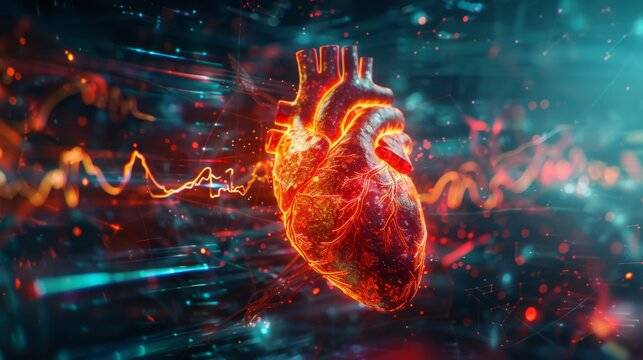Arrhythmias are disturbances in the heart’s normal rhythm, affecting millions worldwide. While many types exist, some are more concerning than others due to their potential to cause severe complications. Understanding these rhythms, their implications, and management is crucial for effective treatment and patient care.
Understanding Arrhythmias
An arrhythmia refers to any irregularity in the heart’s electrical system, affecting the heart rate (too fast, too slow, or irregular). The heart relies on coordinated electrical impulses to contract and pump blood effectively. When this rhythm is disrupted, it can lead to symptoms ranging from palpitations and dizziness to life-threatening conditions like stroke or cardiac arrest.
SEE ALSO: Do Heart Arrhythmias Get Worse with Age?
Types of Arrhythmias
Atrial Fibrillation (AFib): AFib is one of the most common types, characterized by rapid and irregular electrical activity in the atria (upper chambers of the heart). It increases the risk of stroke and heart failure.
Ventricular Tachycardia (VT): VT involves rapid heartbeats arising from the ventricles (lower chambers of the heart). It can lead to sudden cardiac arrest if not managed promptly.
Ventricular Fibrillation (VF): VF is a life-threatening emergency where the ventricles quiver instead of pumping blood.
Immediate treatment with defibrillation is essential to restore a normal rhythm.
Supraventricular Tachycardia (SVT): SVT involves rapid heartbeats originating above the ventricles. While generally not life-threatening, it can cause discomfort and complications in some cases.
Bradycardia: Bradycardia is characterized by a slow heart rate, typically below 60 beats per minute. It may result in insufficient blood flow to vital organs, causing symptoms like fatigue or fainting.
The Most Serious Types of Arrhythmias
Among the various types, some are considered more serious due to their potential to lead to severe complications or sudden death. These include:
Ventricular Fibrillation (VF): VF is perhaps the most serious type of arrhythmia as it can cause sudden cardiac arrest within minutes if not treated promptly with defibrillation.
Ventricular Tachycardia (VT): VT can lead to VF and sudden cardiac arrest if sustained. It requires medical attention to prevent progression to a life-threatening rhythm.
Atrial Fibrillation (AFib) with Rapid Ventricular Response: AFib increases the risk of stroke significantly, particularly if not managed with appropriate medications or procedures to control heart rate and prevent clot formation.
Risk Factors for Serious Arrhythmias
Certain factors increase the likelihood of developing serious arrhythmias:
Heart Disease: Conditions such as coronary artery disease, heart valve problems, or previous heart attacks can disrupt the heart’s electrical system.
Age: Older adults are more prone to arrhythmias due to natural wear and tear on the heart’s electrical system.
Family History: A family history of arrhythmias or sudden cardiac arrest can predispose individuals to similar conditions.
Substance Use: Alcohol, tobacco, and illicit drug use can increase the risk of arrhythmias, especially when used excessively.
Symptoms And Diagnosis
Recognizing symptoms is crucial for early diagnosis and treatment:
Palpitations: Sensation of fluttering or pounding in the chest.
Dizziness or Lightheadedness: Feeling faint or dizzy, especially during physical activity.
Chest Pain or Discomfort: Pressure or pain in the chest, often mistaken for a heart attack.
Shortness of Breath: Difficulty breathing, even at rest.
Diagnosis involves a combination of:
Electrocardiogram (ECG/EKG): Records the heart’s electrical activity.
Holter Monitor: Records heart activity over 24-48 hours to detect intermittent arrhythmias.
Event Monitor: Records heart activity when symptoms occur intermittently over a longer period.
Echocardiogram: Uses sound waves to create a detailed image of the heart’s structure and function.
Treatment Options
Treatment depends on the type and severity of the arrhythmia:
Medications: Antiarrhythmic drugs to control heart rhythm and rate.
Cardioversion: Electrical shock to restore normal heart rhythm.
Ablation Therapy: Destroys abnormal heart tissue causing arrhythmias.
Implantable Devices: Pacemakers to control slow heart rhythms or implantable cardioverter-defibrillators (ICDs) for serious arrhythmias like VT or VF.
Lifestyle Modifications And Prevention
Managing underlying conditions and adopting a heart-healthy lifestyle can reduce the risk of serious arrhythmias:
Healthy Diet: Low in saturated fats, cholesterol, and sodium.
Regular Exercise: Improves heart health and overall fitness.
Stress Management: Techniques like yoga or meditation can help reduce stress levels.
Limit Alcohol and Caffeine: Excessive consumption can trigger arrhythmias in susceptible individuals.
Quit Smoking: Smoking cessation improves cardiovascular health and reduces arrhythmia risk.
Conclusion
While arrhythmias vary in severity, understanding and recognizing serious types like ventricular fibrillation and tachycardia is critical for prompt intervention. Early diagnosis, proper management, and lifestyle modifications can significantly improve outcomes and reduce the risk of complications associated with these potentially life-threatening conditions.


